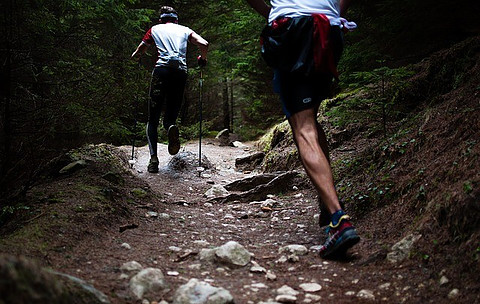
Exercises For ITB Pain – For Runners
Exercises For ITB Pain – For Runners
Let’s look at exercises for ITB pain for runners. Iliotibial Band (ITB) pain can be a debilitating condition which can literally stop us in our tracks. This article will not only go through some effective solutions for the problem but highlight an ineffective treatment you may have tried using in the past.
This article will also give you an understanding of the function of the ITB and the associated muscles.

What is the ITB ?
The Iliotibial Band (ITB) is a tendonous structure that starts on the hip bone and attaches to the glute muscles and the TFL (tensor fasciae latae) which are part of the hip flexor muscles. The TFL is a muscle located on the outside of your hip that helps move your leg outward. As the ITB travels down towards the knee it narrows and attaches to the outside of your lower leg bone (tibial plateau) with fibres also extending over towards the knee (patella).
If you sit in a chair and have your knee joint at approximately 120 degrees open, you can feel the band on the middle of the outside of your leg, just up from your knee.
What is it’s function?
Your ITB is responsible for keeping your hips and knees stable. This is particularly important when running, jumping and walking. When the glute maximus and the TFL contract it applies tension to the ITB, which helps stabilise your knee and hip relationship when it flexes and extends.
Why Do I Get ITB Pain?
Irritation and inflammation of the ITB occur when it is too tight as it travels back and forth over the prominent bone on the outside of the knee (femoral epicondyle.) As the knee flexes and extends while running friction occurs in this outer knee area causing the inflammation.
Pain will commonly present itself at the knee as described. This can be aided with the RICE method in the acute period but it is important to be aware of the full picture. The ITB is a long band of thick, strong fascia and it makes sense that it will also be tight and tender at the other end of the band (where it is pulling from). The top insertion areas (at the TFL and the glute medius) are where we can focus on to find long term relief.
R.I.C.E – Rest Ice Compression Elevation – a common treatment approach for inflammation in the early stages.
Primary Factors Contributing
The most common contributing factor to ITB pain is the under-developed glute medius. When this supportive muscle to the ITB is weak, it lacks involvement which then puts most of the work load onto the TFL muscle. The over worked TFL muscle starts to tighten and therefore pulls on the ITB. This tightness to the ITB results in friction and therefore inflammation over the bone on the outer knee.
Additional Factors Contributing
A secondary factor can be the TFL muscle shortening. This can certainly be the case in cyclists and triathletes. When leaning forward over the bike, the TFL is in a shortened state (this is also the case for people that sit for long periods at a time). With a lack of lengthening to this muscle this can result in a shortened, tight TFL. Which again tightens the ITB, therefore creating more friction at the outer knee when repetitive flexion and extension of the knee takes place (running).
Treating ITB Pain
Attacking the already tight and inflamed ITB with a foam roller will only worsen the problem and put you through immense pain while doing it. As mentioned before, the focus of the problem is either in the glute medius or the TFL or both.
The following are great exercises for ITB pain:
Glute Medius
Strengthening this muscle will add involvement and therefore share the workload with the TFL.
Two great exercises that will strengthen the glute medius are –
1. Side leg lift
2.Clamshell with band
CLICK HERE to watch Jeff Cavalier Physical Therapist explain and demonstrate the exercises for glute medius.
TFL
Rolling or applying pressure to this muscle will decrease the tension in it. Therefore, taking the tension off the ITB. By working on this area where the problem originates you will decrease your tight ITB (Not rolling your ITB that will not stretch).
Two ways to loosen TFL Quadriceps area are –
1. Rolling or applying pressure to the tight TFL
2. Rolling outside of quadriceps
CLICK HERE to watch Jeff Cavalier Physical Therapist explain and demonstrate ITB pain and rolling techniques for relief.
Stretching before and during run
By stretching primarily the TFL before and during your run, you can lower the chances of having major problems while running.
When you are running and feel any tightness at all, it is best to have a quick stretch to hopefully alleviate the problem. The sooner you act on any warning signs the better the chances are of finishing without any problems.
Demonstration of stretch
I hope this information will give you a better understanding and a strategy to diminish any pain in your ITB if it occurs.
If you currently have a tight or inflamed ITB, be sure to work on the areas as shown before you go back to any running.
It is important that there is no inflammation or pain around the knee area before you return. Not taking enough recovery time will result in longer time with pain.
The recovery time will depend on the severity of the inflammation.
I will mention that I am not a medical professional, but have compiled this post though extensive research and also dealing with a tight ITB years ago when competing in triathlon.
If you are having prolonged problems with ITB pain you should consult a medical professional for a thorough diagnosis as some people’s anatomy may predispose them to this problem and other actions may be necessary.
Happy Running,
Andrew.